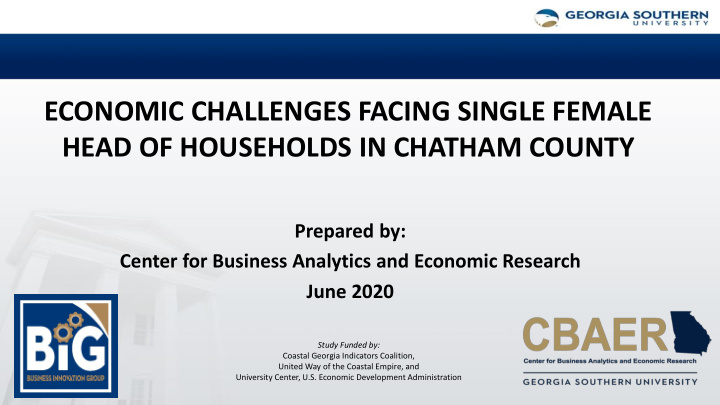



ECONOMIC CHALLENGES FACING SINGLE FEMALE HEAD OF HOUSEHOLDS IN CHATHAM COUNTY Prepared by: Center for Business Analytics and Economic Research June 2020 Study Funded by: Coastal Georgia Indicators Coalition, United Way of the Coastal Empire, and University Center, U.S. Economic Development Administration
Defining Poverty Number of Female-Headed Families Poverty Thresholds by Family Size 3,000 $25,554 $25,465 2,500 $20,231 2,000 $17,308 1,500 $13,064 1,000 500 0 2005 2006 2007 2008 2009 2010 2011 2012 2013 2014 2015 2016 2017 Two Adults & One Adult One Adult & One Adult & One Adult & Savannah-Under 5 years Chatham without Savannah-Under 5 years Two Children One Child two Children Three Children 2
Working Status in Chatham County Chatham County Excluding Savannah Savannah Female-Headed Families Female-Headed Families Working Status Working Status 1,400 2,500 1,200 2,000 1,000 1,500 800 600 1,000 400 500 200 0 0 2017 2018 2016 2017 Full-time Part-time Did not work Full-time Part-time Did not work 3
The Client Survey • Total 79 responses – 39% had no child in home – 67% had one or more children in home • Family’s Outlook Compared to past year – With one or more Children in home • About 46% significantly or somewhat improved • 30% said about the same 4
Largest Financial Challenge 58% 45% 35% 25% 9% 9% 8% 6% 4% 2% 0% 0% 0% 0% Transportation Childcare Medical Housing School Fees Food Other No child in home One or more children in home 5
Are you Currently Employed 35% 35% 32% 25% 23% 19% 13% 8% 4% 4% 4% 0% Employed Full-time Employed Part-time Employed less than Jobs but do not have Unemployed Looking Unemployed not part-time regular employers Looking No child in home One or more children in home 6
Challenges to Keeping a Job, if Employed 48% 24% 10% 7% 7% 3% 0% Job that pays Job close to my Job with flexible Job that matches Job that has Job with Other enough home hours my skill set opportunities for healthcare advancement benefits One or more children in home 7
Finding a Job, if Unemployed 35% 24% 12% 6% 6% 6% 6% 6% 0% Pays enough to Job close to my Job with flexible A job that Job that has Job with Pregnant Health Other pay all my bills home hours matches my skill opportunities for healthcare set advancement benefits One or more children in home 8
Commuting to Work Q8: Willing to Commute, if unemployed Q6: Current Commute to Work 41% 45% 35% 28% 18% 14% 7% 6% 3% 3% Less than 10 10 - 20 20 - 30 30 - 45 45 - 60 More than 1 Less than 10 10 - 20 20 - 30 30 – 45 45 - 60 More than 1 minutes minutes minutes minutes minutes hour minutes minutes minutes minutes minutes hour One or more children in home One or more children in home 9
Childcare Issues Facing Clients Q11: When utilizing childcare, largest Q10: If you use childcare challenge 35% 40% 26% 24% 21% 16% 13% 8% 6% 3% 4% 2% 2% 2% Finding Finding Finding I don’t use I do not have Other affordable quality or childcare childcare issues with Don’t use Family An older A friend Paid in Childcare Family Other childcare reliable with flexible outside of my childcare childcare member child home childcare services childcare hours home sitter home services One or more children in home One or more children in home 10
Largest Transportation Challenge 36% 31% 25% 4% 2% 2% No transportation Affording a personal Maintaining a Lack of access to Public transportation Other issues vehicle personal vehicle public transportation not reliable One or more children in home 11
Current Housing Situation 37% 29% 23% 6% 6% Very stable and secure Fairly stable and secure Only somewhat stable Fairly unstable and Very unstable and and secure insecure insecure One or more children in home 12
Level of Income 73% 60% 19% 15% 10% 8% 8% 4% 4% 0% Under $10,000 $10,000 - $15,000 $15,000 - $20,000 $20,000 - $30,000 More than $30,000 No child in home One or more children in home 13
Currently Receiving Aid • No Child in Home • One or more Children in home – SNAP Food Assistance – SNAP – Medicaid/Medicare – WIP – Housing Assistance – Medicaid/Medicare – Earned Income Tax Credit – Peachcare – Disability Benefits – Housing Assistance – Childcare Assistance – Earned Income Tax Credit 14
Conclusions • This is likely a high for this group • Survey participants are asking for classes that focus on – Financial Literacy/Budgeting (n=45 total) – Parenting Classes (n=7 total) – Time Management (n=8 total) – Renter’s Rights (n=20 total) – Health and Health and Nutrition (n=11 total) 15
Recommend
More recommend